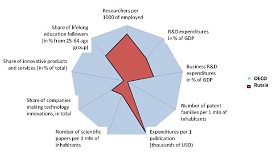Interview
Finland is one of the top European countries in innovation and Russia is at the beginning of its path to innovation. Nevertheless, the Russian-Finnish cooperation in knowledge-intensive activities has been rapidly developing and can serve as a role model for Russia’s innovation cooperation with the European Union. Kari Liuhto, Professor on the Russian economy at the University of Turku, speaks about the Russian-Finnish experience in knowledge-intensive activities and provides some ideas for the EU-Russia innovation cooperation.
Interview
Finland is one of the top European countries in innovation and Russia is at the beginning of its path to innovation. Nevertheless, the Russian-Finnish cooperation in knowledge-intensive activities has been rapidly developing and can serve as a role model for Russia’s innovation cooperation with the European Union. Kari Liuhto, Professor on the Russian economy at the University of Turku, speaks about the Russian-Finnish experience in knowledge-intensive activities and provides some ideas for the EU-Russia innovation cooperation.
Interviewee: Kari Liuhto, Professor on the Russian economy, University of Turku, Finland
Interviewer: Maria Prosviryakova, Russian International Affairs Council
What is motivation behind the EU building innovation cooperation with Russia?
I see it as a part of an overall integration process, as part of an overall relationships between the European Union and Russia. So, it is a part of a bigger picture. The European Union is committed to the future of the Russian Federation. It is trying to build a future together, to build as many bridges as possible. Innovation and modernization are some of those bridges.
Does this coincide with Russia’s goal for innovation cooperation with the EU?
The European Union targets a broader socio-political modernization in Russia, whereas Russia is more focused on industrial restructuring. In other words, the European Union wants to develop Russia’s political foundations and to westernize Russian society, whereas Russia sees modernization as a means to increase the competitiveness of its industries. This is one of the main differences of innovation “ideologies” between the European Union and Russia; and this is perhaps the biggest challenge of how to find the common nominator between these two approaches.
According to the 2012 Global Innovation Index Russia is ranked 51st out of 144 countries, whereas most EU countries are at the top of the ranking with Switzerland and Sweden being ranked 1st and 2nd accordingly, and Finland – 4th. Well, Russia has started its innovation development relatively recently compared to the top European countries in innovation. What major challenges do you believe Russia needs to overcome on its path of innovation development?
First of all, we need to acknowledge the fact that the Soviet Union collapsed around two decades ago. The first decade was focused on survival from the collapse. The second decade can be called “building the modern Russia”. So, the whole process of modernization started in this millennium.
Secondly, innovation takes time; and ten years of modernization and innovation reforms is a very short period of time. The modern Russia will need decades to mature. Perhaps, Skolkovo will take quite long time before it will start developing new ideas.
One of the weak points of the Russian current system is the top-down approach. Of course, Russia has state projects such as Skolkovo, Rusnano, the Russian Venture Company (RVC) and some others but this is not enough. The motivation for innovation should emerge from bottom-up: you need to have grass-root players - innovative entrepreneurs who are interested in promoting innovation not as a sole goal but as part of their broader agenda.
Another point is that innovations don’t appear when somebody just wants them, there should be a need for innovation. You have to have a force that is making companies to change their behavior. Innovations usually start not when there is an opportunity, rather when there is a need to survive – which is so called “Corporate Darwinism”. So far Russia has had poor natural business demand for innovations. The country is rich with natural resources and its well-being has been growing. Thus, Russia was doing just fine without any innovations.
The role of the state in innovation is different in Russia from other countries. If you look at the funding of the R&D in Russia, it is even less than in China. There is a common perception that the state support for science is not an innovation, whereas in Russia the R&D finance is dominated by state investments – about 70%.
It is very important that private companies engage in the innovation process understanding that they need to innovate, because it will help them survive the competition.
In March 2011 Russia and Finland signed the modernization declaration that made the cooperation between the two states more active. Could you talk about some successful examples of such cooperation and their main foci?
Finland and Russia are traditional partners. Russia is playing a significant role in Finland’s foreign trade. It is the main target of Finnish high-tech goods, representing a tenth of the Finnish high-tech exports. Finland’s share in Russia’s foreign trade is around 2%; and given relatively small size of Finland (with the population of 5.3 million), compared to Russia, it is quite an achievement.
There are multiple academic and business examples of this cooperation. I will name just some of them. For example, Russian-Finnish joint venture between Russia's United Shipbuilding Corporation (USC) and STX Finland Oy specializing in Arctic shipbuilding in Helsinki. Thus, the Arctic region creates a great potential for cooperation Another area of cooperation is nanotechnology investment: in 2010 government-owned investment company Finnish Industry Investment Ltd and Russian Corporation of Nanotechnologies (RUSNANO) signed an agreement with the aim to co-invest in rapidly growing and internationalizing nanotechnology companies operating in both Finland and Russia.
An aggressive growth of the Russian biomedical market also opens opportunities to the Russian-Finnish partnership. Thus, this June Skolkovo science and technology cluster and Turku Science Park Ltd signed an agreement of cooperation in the field of biotechnology. The objectives of this agreement are to accelerate the commercialization of scientific research and support the creation of Public-Private Partnerships.
A global network of Finnish innovation organizations - FinNode established FinNode units in St. Petersburg and Moscow in order to facilitate inter-enterprise innovation cooperation.
There are various forums, such as EU-Russia Innovation Forum, and the 4th meeting will take place in June 2014 in Finland.
Some of the Finnish universities have established special units to follow the development in Russia. Finland is also interested in bringing up Russian young entrepreneurs or even students who are willing to start their own business with Finland.
So, the 2011 agreement was a political catalyst that significantly increased Russian-Finnish cooperation on all levels. Nevertheless, it should be noted that Finland was creating structures to facilitate and finance bilateral innovation activities long before this agreement. The goal of the Russian-Finnish cooperation is to jointly create new products and services but so far high-tech cooperation is still dominated by exports of Finnish high-tech goods to Russia and the upgrading of existing goods together.
In your article on the EU-Russian innovation collaboration, you suggested 12 policy recommendations based on Finnish-Russian innovation collaboration experience. Could you comment on some of the most important ones for enhancing EU-Russian innovation collaboration?
I will be very pragmatic. We should not concentrate on radical innovations, but instead focus on incremental innovations, which means the constant improvement of joint production. There are around 1000 Finnish companies in Russia that on daily basis are working on improving not only technological operations but also services, which will play increasingly important role in the future. Though top scientists and politicians favor radical innovations due to their publicity, continuous product and service improvement is usually the most rewarding for society as a whole.
Other recommendations can be summarized as follows:
- Establishing a joint EU-Russia Innovation Centre both in Russia and in the EU to bring together the innovation-intensive firms of Russia and the European Union;
- Supporting the internationalization of innovations through the adaptation of existing Western innovations into the Russian market and the internationalization of the Russian goods toward the European Union;
- Turning the innovations conducted in the military sector into civilian use in Russia;
- Improving intellectual property rights and the investment climate, as one of the main weaknesses of the Russian investment climate is over-bureaucracy and corruption linked to it;
- Carrying out institutional innovations (e.g. transforming the Russian Academy of Sciences (RAS) from a research unit into a research-funding organization);
- Designing a service innovation policy;
- Enhancing management innovations;
- Creating innovation competition (e.g. publishing a list of the most innovative regions in Russia; national and regional innovation competitions among firms and citizens);
- Establishing innovation journalism to share best practices;
- Teaching creativity and entrepreneurship in universities;
- Avoiding political stagnation.
Source: Liuhto, 2011
Russia and Finland have built quite a few organizations - private and state funded. Finland also has a long tradition of cooperating with Russia, whereas Western European countries have formed certain political stereotypes about Russia; and the way to dismantle them is to visit Russia and see everything with their own eyes.
To conclude, innovation cooperation requires a lot of trust between the partners, since we are building something that did not exist earlier, and hence, immaterial rights and their respect is essential to guarantee that we will have success stories in the joint innovation activity. Therefore, it is utmost important that Russia continues strengthening its investment climate and country image as an innovation friendly country. The EU and Russia can together overcome the future challenges facing our societies and competitiveness. Let’s go forward together.







